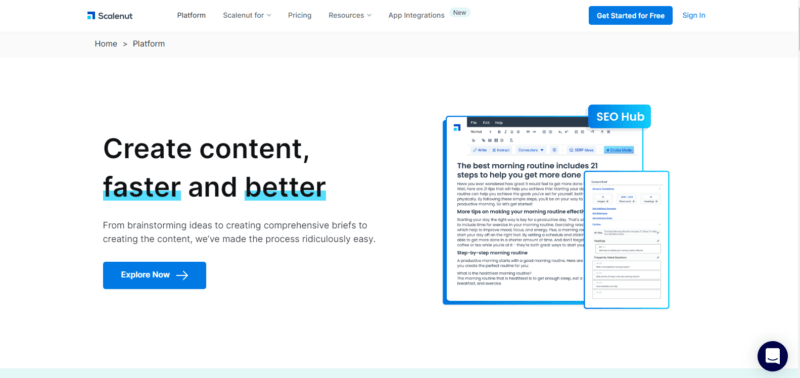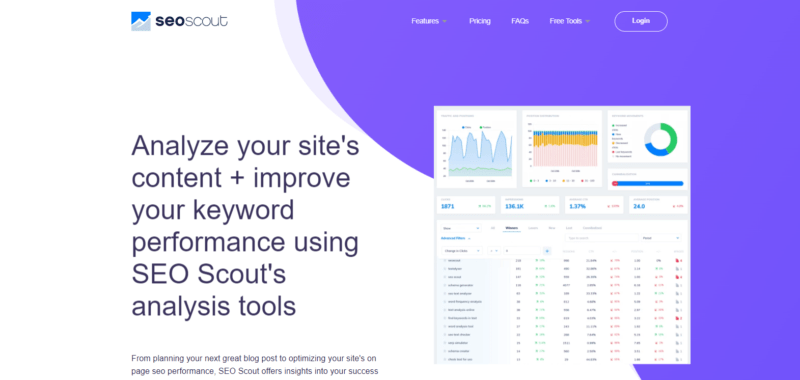What is keyword stuffing, and are you accidentally doing it?
Even though most people nowadays are aware that keyword stuffing is bad (black hat), it's still a common practice and often done accidentally. How? Because there's a slight misconception about what keyword stuffing actually refers to.
I constantly see beginner bloggers and content writers make this mistake all the time. I used to do this myself, and once I shifted my focus away from keywords, I noticed a major improvement in my search rankings and overall traffic.
But what was I doing wrong? Simply put, I was unintentionally keyword stuffing my content, and you might be doing this too. Google's search algorithm has changed, so your tactics need to as well.

In this article, you will learn what keyword stuffing is, how to avoid it, and what to do instead to supercharge your content and dominate your competitors.
Learning Objectives
Three Types of Keyword Stuffing
Why Keyword Stuffing Is Bad
What to Do Instead of Keyword Stuffing
How to Supercharge Your Content
What Is Keyword Stuffing?
My definition: Keyword Stuffing is the act of nefariously saturating (or stuffing) a webpage with keywords in a single piece of content to boost that page's ranking in search engine results, such as Google. Most people think of this when they hear the phrase “keyword stuffing.”
Google's definition: “Keyword stuffing” refers to the practice of loading a webpage with keywords or numbers in an attempt to manipulate a site's ranking in Google search results. Often these keywords appear in a list or group, or out of context (not as natural prose).

From Matt Cutts: Keyword stuffing is almost like a grab bag term to describe many different things, such as repeating words, mixing them up to create “like terms,” and using them in unnatural ways that read like gibberish.
A Brief History of Keyword Stuffing
Keywords with exact matches once carried a great deal of weight. The page would rank well if it contained a keyword precisely as the user typed it in Google.
As people discovered that they could rank their site for more queries by repeating different variations of keywords on a single page, keyword stuffing was born.
It was possible to rank well by stuffing relevant keywords into web copy and entire paragraphs containing only SEO keywords separated by commas.
SEO's early days were like the Wild West, as people say. Back then, websites weren't penalized for keyword stuffing; they benefited from it.
Florida Update
With Google's first significant algorithm update in 2003, the Florida update changed the impact of keyword stuffing on search rankings.
In addition to targeting link spam, the Florida update also affected sites engaging in other spammy techniques. Despite Florida's efforts, the impact on keyword stuffing was minimal.
Panda Update
Then, in 2011, Google released the Panda update that targeted low-quality websites with little or no added value.
Panda, being more effective than Florida, invariably led to keyword-stuffed pages being demoted in search results as they added less value to the internet.
After the Panda update, Google strictly advised against keyword stuffing, but Google still had more to say.
Hummingbird Update
In 2013, the Hummingbird update put the nail in the coffin with the introduction of Natural Language Processing. As a result of Hummingbird, content writing approaches have changed, especially regarding the unnatural usage of keywords.
As a result of Hummingbird, the focus shifted from writing for search engines to writing for humans.
The purpose of keyword stuffing was solely to manipulate rankings, not to offer value to searchers. It's an outdated technique now that Google's search algorithms are more adept at recognizing quality content.

Nowadays, SEO is about creating content for human readers, NOT robots and web crawlers.
3 Types of Keyword Stuffing
Here are three different types of keyword stuffing and their definitions. Pay close attention to the last one. It might sound very familiar!
1. Visible
Definition: Visible keyword stuffing is the intentional act of overusing a single keyword throughout web content to boost page rankings in Google search results. Often, this includes the obviously forced usage of long-tail keywords and reads like spam.
The practice of visible keyword stuffing may take on a variety of shapes, and it stretches beyond the repeated use of a specific word or phrase. Examples of keyword stuffing include:
- Unnecessarily repeating specific terms or phrases in the content.
- Using irrelevant keywords or search terms.
- Adding keywords or terms that are out of context.
- Using keywords or search terms in unnatural ways.
2. Invisible
Definition: Invisible keyword stuffing is the practice of using your keywords in ways that search engine crawlers can read them but users cannot.
For instance, adding keywords with white font colors to articles with a white background is an example of invisible keyword stuffing. Other examples include: overusing keywords in alt-tags, meta descriptions, comment tags, and other website code.
3. Unintentional
Definition: Unintentional keyword stuffing is a term I invented to explain the phenomenon of using keywords responsibly but ultimately wrong.
For example, cautiously adding many keywords (or LSI words) throughout your article with a reasonable keyword density is STILL considered keyword stuffing in my book.
Trying to use as many keywords in your article without overusing them to avoid a penalty is, in fact, keyword stuffing. Simply because you're not technically overusing (or stuffing) a single keyword into your article doesn't mean you're not “keyword stuffing.”
If you're twisting your keywords and adding as many synonyms or LSI words into your article, you ARE keyword stuffing.
I refer to this as unintentional keyword stuffing because while many content creators and beginner bloggers are trying to use their keywords responsibly, they're simply being ignorant.
You might not incur any Google penalties, but you're not doing yourself any favors, either. Google's work on the Knowledge Graph and advances in Natural Language Processing (NLP) means they can detect your lousy keyword-stuffed page regardless of keyword density (the number of times a specific keyword is used).
The bottom line: If you're blindly filling pages with keywords, secondary keywords, LSI words, and synonyms in an attempt to increase your search rankings, you're unintentionally keyword stuffing your content, and it's negatively impacting your SEO efforts.
3 Reasons Keyword Stuffing Is Bad
Keyword stuffing was a relatively successful SEO strategy once upon a time, but today stuffing keywords into your content is a fruitless endeavor.
1. It's Not User Focused
Keyword stuffing isn't user-focused. Google prefers serving content that caters to the searcher's intent and desires, not which page has the most closely matching keywords.
In fact, many of the top-ranking pages don't include many of the keywords they rank for in their content, and Google doesn't care!
Google serves the content anyway because Google is convinced that those pages best fit the needs of the user, regardless of keywords.
2. It Isn't a Ranking Factor
If you want to improve your SEO (Search Engine Optimization), you should be catering to User Intent, not keyword usage. Keyword density is NOT a ranking factor. Using your keyword once is just as powerful as using it 20 times.
Do you really think Google can't figure out what you're saying unless you say it 20 times? Using your keywords unnaturally waters down your content and results in a negative user experience. Really, nobody wants to read that spammy crap.
3. It's Holding You Back
Focusing on keywords is a waste of time. It's time-consuming and results in poorly written articles that fail to match user intent. Your keyword usage doesn't help anyone but yourself, and Google knows it.
All that time and energy you put into your keyword research would be better spent writing useful content that caters to the user.
Just imagine all of the amazing content you could create if you weren't so worried about using keywords!
What to Do Instead of Keyword Stuffing?
Keyword stuffing your blog isn't doing you any favors, so it's time to move on. Instead, you should focus your efforts on content creation. That is creating high-quality content that beckons to be read.
Keyword tools such as ahrefs have their uses, but they aren't all that helpful. I threw out all of my keyword tools long ago and couldn't be happier. Keyword research was such a boring drag that felt like a chore.
Nowadays, I only use content creation tools. My content is better, and my overall page rankings have increased. Plus, I spend more time doing what I love (writing). It's truly a win-win situation.
Keywords should be used as a guide for content priority, topic research, and search-intent discovery. They aren't supposed to be used for tricking Google.
5 Reasons for Using Content Creation Tools
Instead of focusing on keyword stuffing, keyword research, and which keywords you should use, redirect your efforts to creating high-quality content with the aid of content creation tools.
1. It Guides Your Content Creation
Unlike keyword tools, content creation tools guide your content from start to finish by streamlining the entire content writing process. It's much more intuitive and provides valuable insights at every step required to top the SERPs.
2. Topic Research Is a Breeze
If you want to improve your chances of ranking at the top of the SERPs, you must convince Google that your article sufficiently covers your topic and answers the user's search intent, which is something that keyword stuffing doesn't do.
Streamlining topic research is where content creation tools really begin to shine. Using tools like Scalenut, you get access to valuable competitor insights that you can use to your advantage.
This includes the suggested word, image, and heading counts, as well as NLP-extracted terms, top citations, commonly asked questions and a readability score.
All of these insights contribute to creating information-rich content that Google and your readers will love.
3. Its User-Intent Focused
Content creation tools help you create content that is oriented to the user's search intent. This is what Google wants to serve users.
With Scalenut, you can get in-depth audience insights at a glance to help you create user intent-focused content.
4. You'll Rank For More Keywords
Ironically, you will rank for MORE overall keywords when you create content based on user intent. How is this possible?
Blindly stuffing different keywords into your content causes your writing to suffer and restricts you to a handful of keywords because you can only use so many terms without sounding odd or forced.
On the contrary, when you focus on matching user intent, Google is much more likely to serve your page for your primary keyword (or topic) and ALL of its odd variations and related keywords.
This means you don't need to figure out how to add that strangely worded keyword into your content to rank for it.
5. Eliminate Writer's Block
Do you sometimes have trouble finishing sentences? AI writing technology can help you bust through that writer's block to produce quality, well-researched, and exciting content.
Content creation tools like Scalenut can help you churn out high-quality, engaging content with a simple button click. Can your old-fashioned keyword tool do that?
Top 5 Content Creation SEO Tools
If you want to write better content, improve your SEO, and increase page rankings and overall traffic, it's time to throw out those silly keyword tools, stop keyword stuffing and focus on creating high-quality content.
Let's take a look at the top 5 best tools to push your content to the next level.
1. Scalenut

Scalenut is the best content creation tool on the market for SEO purposes. It allows you to create information-rich and user-focused content in minutes, which will help your page rank higher and attract more visitors.
I've used every content creation tool out there, and my favorite by far is Scalenut. The interface is intuitive, and the wide range of tools is much welcomed.
Lock in your 60% off while you can and take your content to the next level. You'll never look back!
2. Frase

If Scalenut isn't for you, Frase is just as good, and the price is even better. With Frase, you get everything you need at an unbeatable price, and if you act now, you can take 20% off any plan forever.
Check out their content dashboard for free, right on their homepage. No login or credit card is required.
3. SurferSEO

Founded in 2017, SurferSEO offers all of the expected content creation tools with a few disappointing caveats.
Jasper AI writing integrates into SurferSEO but requires its own subscription, and with NLP words in the Pro plan only, you're looking at spending a pretty penny each month compared to the previous options on this list.
That aside, SurferSEO is an excellent content creation tool, much more suited to beginner content writers than convoluted keyword tools like Semrush.
4. SEOScout

SEOScout is another content creation tool with an advanced content editor and Grank tracker powered by Google Search Console but doesn't offer any AI writing tools.
5. MarketMuse

MarketMuse is geared more towards large enterprises but offers 15 free search queries monthly for optimizing your content as needed.
Often, I pop my articles into MarketMuse to get a free second opinion on the Google-extracted NLP words. Why not, right?
FAQs
Is keyword stuffing still a thing?
Try as you may, you won't see any good results. You might be able to rank for low-difficulty keywords, but to top the SERPs for the most difficult ones, your content must be impeccable, which means creating high-quality content crafted with love for the user.
How can I avoid keyword stuffing?
Your best bet to avoid keyword stuffing is to ironically stop worrying about keywords and keyword density altogether. Instead, focus on matching your content to the user intent for better results.
Is it possible to rank a page without using keywords?
Inevitably, your page will rank for certain keywords over time on its own. However, you can rank a page without using keywords in the traditional sense by targeting topic clusters instead of keywords.
What are irrelevant keywords?
According to Google, “irrelevant keywords” are keywords that are used without adding substantial value or substance to them.
How to check keyword stuffing?
If you have to check if you're keyword stuffing, you're probably using keywords wrong. Keywords are guides for creating quality content, not an SEO metric. Nonetheless, you can use this free online tool for measuring keyword density.
What is the optimal keyword density?
While many will say the optimal keyword density is around 2%, there is no sweet spot, as the keyword density isn't a ranking factor.
Conclusion
In conclusion, keyword stuffing is a common technique that can harm your content's quality and Google ranking.
However, using content creation tools such as Scalenut will help you avoid this problem and focus on creating high-quality, user-centric content that will attract more traffic and improve your SEO efforts.
Questions? Let me hear it in the comments section below!

Thi cong noi that cao cap sang trong, thi cong noi that biet thu, chung cu, van phong
https://www.ibm.com
https://www.ibm.com
not working
thanks, interesting read
nothing special
Cool + for the post
very interesting, but nothing sensible
Cool, I’ve been looking for this one for a long time